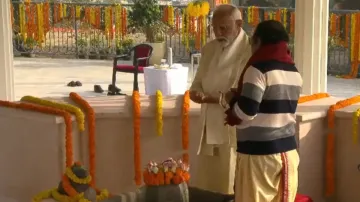Prime Minister Narendra Modi's visit to Ayodhya included a significant spiritual journey within the Ram temple premises. Prime Minister Narendra Modi visited the Kuber Tila on the premises of the Ram temple in Ayodhya. His visit included the offering of prayers to Lord Shiva at the ancient Shiv temple located on the Kuber Tila. The prime minister performed 'jalabhishek,' symbolising the ritualistic offering of water on the 'Shiva linga.'
Ayodhya pilgrimage is incomplete without visit to Kuber Tila
It is believed that a journey to Ayodhya remains incomplete without paying homage to Lord Shiva through 'jalabhishek' at Kuber Tila.
Here's a glimpse of the spiritual significance of Kuber Tila:
Mythological heritage
- According to mythology, the wealth deity Kuber visited this place centuries ago.
- Kuber established a Shiva Linga near the birthplace of Lord Rama, initiating the worship of Ram Lalla.
- Alongside Ram Lalla, the site hosts idols of Lord Ganesha, Goddess Parvati, Lord Kartikeya, Lord Kuber, and Nandi, forming the 'Nau Devi' shrine on Kuber Tila.
- The presence of these deities gives Kuber Tila the name 'Nau Ratna.'
Importance of Kuber Tila
Similar to Lord Rama's worship of Lord Shiva in Rameshwaram for victory over Ravana, the Shri Ram Janmabhoomi Teerth Kshetra Trust performed the 'dugdhabhishek' ritual for Lord Shiva at Kuber Tila before initiating the construction of the Ram temple.
Kuber Tila holds significance not only in religious and mythological contexts but also possesses archaeological importance.
Historical background
- Kuber Tila featured in the identification of 148 locations during the 84-kosi parikrama in 1902 in Ayodhya.
- The Archaeological Survey of India (ASI) included Kuber Tila in the conservation list of eight significant sites in Ayodhya.
- The locals share stories of Lord Shiva's procession from this site, but this tradition ceased after terrorist attacks in Ayodhya.
Statue unveiling and restoration
- Prime Minister Narendra Modi unveiled a statue of 'Jatayu' during his visit to Ayodhya, emphasising the rich cultural and religious heritage.
- Kuber Tila witnessed renovation along with the construction of the Ram temple, reflecting India's commitment to preserving historical and spiritual sites.
Symbol of unity
- Kuber Tila carries historical importance during India's struggle for independence.
- It symbolises Hindu-Muslim unity as Baba Ram Sharan Das and Amir Ali were hanged by the British here.
- The restoration of Kuber Tila, along with the construction of the Ram temple, signifies the collective cultural and spiritual heritage of Ayodhya.
PM Modi's visit to Kuber Tila not only holds religious importance but also highlights the restoration efforts and unity embedded in Ayodhya's diverse history.
Also read | 'Ram Lalla will no longer live in a tent': PM Modi addresses gathering after 'Pran Pratishtha' in Ayodhya
Latest India News

